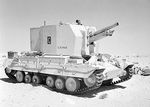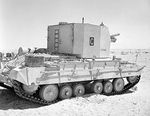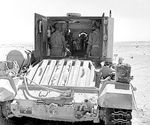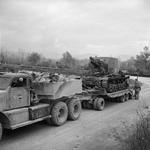Valentine Bishop
| Country | United Kingdom |
| Manufacturer | Vickers-Armstrongs, Limited |
| Primary Role | Self-Propelled Gun |
Contributor: Alan Chanter
ww2dbaseThe Bishop was the first British effort at a self-propelled gun and was useful in showing the potential of the type and what to avoid in future designs. Throughout 1941 the British and Commonwealth Divisions in the Western Desert had little to combat the well armoured German Medium Tanks apart from the almost useless Boyes Anti-Tank Rifle and the issue 2-pdr (40mm) Anti-Tank gun of the Divisional Anti-Tank Regiments. Whilst these were reasonably effective against lightly armoured Italian Tanks, they were completely inadequate to take on the more heavily armoured German Tanks (PzKfw III and IV) employed by the Panzer Regiments of Rommel's Afrika Korps (DAK). The only really effective way of tackling the Panzers was to employ the Royal Artillery's 25-pounder Field Batteries in the anti-tank role. Although these were quite able to knock out the German Tanks they unfortunately lacked the mobility and protection necessary for warfare in the open expanses of the North African terrain and lacked a suitable AT round. Unlike the Germans, who had been developing self propelled guns since 1938, the British had not envisaged a use for such vehicles ever since the Birch gun had been rejected by the Royal Artillery in 1925. Consequently when the British Army in the Middle East experienced the effects of German self-propelled artillery it would not take long before they were demanding a similar weapon. A hasty solution was urgently required.
ww2dbaseDesign work was undertaken by the Birmingham Railway Carriage and Wagon Company whose first proposal was to fit a 25mm anti-tank gun into a Valentine tank. This proved unsuccessful and it was then suggested that it should be possible to fit a 25-Pdr Mk II howitzer on the tank chassis if the turret was removed and replaced with a rigidly mounted, high, slab sided armoured box. Using the Valentine II, powered by an AEC 131 bhp diesel engine, chassis as the basis, production commenced at Vickers Ltd factory at Elswick in early 1942, and the first vehicles, now named the "Bishop" (the nomenclature is thought to have originated at the 121st Field Regiment RA), reached the Western Desert in time to participate in the 2nd Battle of El Alamein (October 1942).
ww2dbaseThe Bishop unfortunately suffered from a number of drawbacks. It was slow (13 mph) and uncomfortable, and the confines of the box meant that the gun could not achieve maximum elevation (elevation of 15 degrees and depression of 5 degrees) which therefore severely restricted the guns range to just 5852 metres (6400 yards) -less than half the range it could reach on a normal field carriage. The four man crew were severely hampered in their work by the space within the box which also had to accommodate the 32 rounds of ammunition in addition to the space taken up by gun and crew. The guns traverse was equally poor at just a mere 8 degrees. In addition the Bishop's high silhouette was found to make an excellent target for enemy gunners.
ww2dbaseBy the time the Bishop was introduced, the 25-pounder was no longer being used in an anti-tank role. By late 1942, this role was being increasingly assumed by the new 6-Pdr (57mm) anti-tank guns which were beginning to arrive in theatre in significant quantities. So the Bishops were diverted for artillery use.
ww2dbaseOne hundred Bishops were built by July 1942, and nearly all of them were used in the North African campaigns, although some continued in action in Sicily and in the first few weeks of the Italy campaign. It was replaced as soon as possible by the American built 105mm M7 Priest or the Canadian 25-pdr Sexton. As a design to meet an emergency, the Bishop served its purpose adequately at an important time of the war, but perhaps the Bishops most useful function was as an instructional vehicle to teach regiments the rudiments of self-propelled gun tactics.
ww2dbaseSources:
The Illustrated Encyclopaedia of Military Vehicles (Ian V Hogg & John Weeks,-Hamlyn, 1980)
Armoured Fighting Vehicles (Philip Trewbitt, Dempsey-Parr, 1999)
Tanks and other Armoured Fighting Vehicles 1942-45 (B. T. White, Blandford Press, 1975)
Tank Battles in Miniature (Donald Featherstone, Patrick Stephens ltd, 1977)
Last Major Revision: Sep 2009
SPECIFICATIONS
Valentine Mk I Bishop
| Machinery | One AEC A190 diesel engine rated at 131hp |
| Suspension | Coil sprung three-wheel bogies |
| Armament | 1x QF 25pdr howitzer (32 rounds), 1x7.7mm Bren machine gun |
| Armor | 8-60mm hull, 13-51mm superstructure |
| Crew | 4 |
| Length | 5.53 m |
| Width | 2.63 m |
| Height | 2.83 m |
| Weight | 17.0 t |
| Speed | 24 km/h |
| Range | 145 km |
Photographs
 |  |  |  |
Você gostou deste artigo ou achou este artigo útil? Se sim, considere nos apoiar no Patreon. Qualquer valor já vai ajudar! Obrigado. Por favor, ajude-nos a divulgar o site: Fique atualizado com WW2DB: |

- » Wreck of Teruzuki Found (27 jul 2025)
- » USS Orlean's Bow Found (22 jul 2025)
- » The Emperor of Japan Planned to Honor WW2-era Japanese POWs in Mongolia (4 jul 2025)
- » US State Lawmaker John Winter Caught Using Racial Slur "Jap" and Apologized (11 jun 2025)
- » US Government Plans to Purge WW2 Information (17 mar 2025)
- » Ver todas as notícias
 |
- » 1,181 biografias
- » 337 eventos
- » 45,111 entradas na linha do tempo
- » 1,246 navios
- » 350 modelos de aeronaves
- » 207 modelos de veículos
- » 376 modelos de armas
- » 123 documentos históricos
- » 261 instalações
- » 470 eventos
- » 28,473 fotos
- » 365 mapas
Thomas Dodd, late 1945
Por favor, considere nos apoiar no Patreon. Mesmo R$1 por mês já faz uma grande diferença. Obrigado!
Ou, por favor, nos apoie adquirindo alguns produtos do WW2DB na TeeSpring. Obrigado!